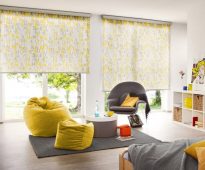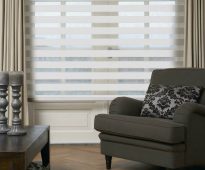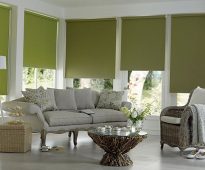What is tulle veil: description, types, reviews
There are several types of fabrics used for the manufacture of tulle curtains. Each of them has its own advantages, which can be used to create the interior. Veil - tulle, which is best suited for rooms whose windows overlook the sunny side.
Window design is very important in the interior of the room.
Content
Features of the veil
The veil tulle is a translucent, smooth fabric with a dense structure and a matte surface. The main curtain of the veil from the other curtains of tulle - the ability to skip diffused light hiding the situation from prying eyes. It is this material that best of all manifests itself in rooms facing the sunny side and in rooms whose window openings are not closed by thick curtains or curtains.
One of the types of curtains for decorating the window is a tulle veil.
Materials for the production of veils
Tulle veil is made from both synthetic and natural fibers:
A tulle veil is a translucent fabric designed to decorate a window.
- silk - has an unsurpassed appearance, very smooth and soft, but it is expensive and inferior in strength to synthetics;
- cotton - looks almost the same as silk, but much cheaper;
- synthetics is cheaper than natural, but does not require special care, does not hesitate, does not fade, it is easy to iron, it has a higher light transmittance.
Blended fabrics are also produced, in which artificial and natural threads are combined.
Its main feature is the ability to transmit sunlight, while scattering it, which is especially important in darkened rooms.
Types of veil tulle
Tulle veil can have a different shape.
The veil has a smooth and soft, well-kept drapery.
- A rectangular canvas covering the window opening with freely falling folds. They are hung as a single curtain, and two connecting parts. The color is chosen under the general palette of the room. Multiple layers of fabric can be used to create volume.
- Crossed pair of canvases. Rectangular pieces are fixed on the eaves, and below they are assembled at opposite sides of the window with the help of accessories.
- French curtain - the canvas is going to shuttlecocks, which can be raised or lowered, adjusting the height of the curtains.
- Lambrequin - a tulle veil fantasizes over a rod of a cornice.
Care for this type of fabric is simple, does not require special tools, it is easy to wash and iron.
For which premises is suitable
The tulle veil can be picked up to the room of almost any destination.
- Children's
Tulle-veil adds comfort, does not interfere with lighting, but scatters bright sunlight. White or pink curtain-lambrequin is perfect for the girl's room, and any child will like the choice of tulle with photo printing of favorite fairy-tale characters.
The perfect combination in the children's room tulle curtains and curtains.
- Kitchen.
When selecting a veil for the kitchen, it is preferable to stop the choice on a synthetic fabric that is more durable and practical.It does not lose sight with numerous washings, it is easy to iron and is used longer.
Tulle-veil can be made from natural fibers, and be fully synthetic.
- Bedroom.
An excellent design move will be a tulle-veil, hung from the inside over a thick curtain. This option gives extra comfort and outwardly makes curtains easier.
Tulle-veil does not shrink during washing, less wrinkled during use, practically does not fade
- Living room.
A veil curtain is ideal for a living room made in a classic or romantic style. In this case, single-colored curtains are preferable, the color of which is in harmony with the general furnishings; a combination of several canvases with different colors is permissible.
White voilevaya curtain is a classic in the design of the window.
Comparative characteristics of the veil, organza and mesh
Despite the similar effect of different types of tulle, due to which the curtains of this type do not darken the room and freely let in the sunlight, each of them has its own advantages and disadvantages.
The ideal option would be a combination with dense curtains.
Veil
A more dense structure than the grid and organza allows not only to contain too bright solar streams, and hides defects in window openings, slopes and walls, deficiencies in repair and the window view that does not suit the owners.
Those who decorated the windows in their home with tulle-veil are mostly satisfied with the result.
It is almost weightless, very soft fabric, which allows to create a romantic mood thanks to flowing drapery, delicate folds or lambrequins. The veil is suitable for experiments with the simultaneous use of different shades and colors in one window. This type of tulle is best kept back by the rays of the sun, so it is good to hang it on the windows facing the sunny side.
Another plus is that the canvas from the veil is very soft, which allows you to easily solve complex design problems.
Advantages:
- moderate transparency;
- airiness and softness;
- wide range of colors;
- simplicity of drapery - the fabric is easy to process when creating the desired decorative composition.
It turns out the airy interior, because it is well scatters light, but is not completely transparent.
This fabric has some disadvantages:
- low strength - easy to tear;
- veil spots are difficult to remove and visible in the rays of light;
- wrinkled when stored in a collapsed form - fold the veil should be twisted roll;
- a veil of natural materials demanding to care, does not tolerate the spin, ironed through a damp cloth, washed by hand;
- electrifies, therefore attracts dust;
- fades in the sun, applied drawings lose color over time.
This is ideal for daytime windows on the south side.
Organza
The fabric is light, thin and very transparent. The technology of creation combines synthetic fibers from polyester and sometimes from viscose and natural silk. The fabric is quite expensive due to the complexity of the production, during which it goes through several stages.
Remarkable decorative properties and qualities of the material justify its price.
Despite the apparent external lightness, the fabric has high elasticity and durability. Curtains made of organza are characterized by a long service life without loss of quality.
Veil curtains are the most popular decor for windows of residential premises.
A wide range of organza species is produced: with patterns and one-color, brilliant and matte canvas, perforated and cushioned fabric, material with sputtering and embroidery. Recently even an organza-chameleon has appeared, changing color and tone at different viewing angles or changes in the level of illumination.
This fabric is very light, transparent, amenable to draperies of different types.
Advantages of organza:
- airiness and almost complete transparency;
- ease of care;
- undemanding to washing conditions;
- no burnout for a long time;
- good compatibility with drapery fabrics;
- low dust pull.
The veil includes all thin transparent materials obtained by the method of plain weaving, regardless of the composition of the fabric.
Organza is good to use in rooms with low illumination: it creates a feeling of closure of window openings, but practically does not hold sunlight.
Almost weightless canvases perfectly let in the sunlight, they look stylish and elegant.
There is this type of tulle and disadvantages, which, above all, include puffs and other defects that can not be quietly corrected while preserving the integrity of the fabric. Therefore, it can hardly be recommended to those who have animals at home.
Good transparency of the veil makes it possible to form beautiful folds on the curtain.
Grid
The tulle net has a completely different structure than the veil or organza. This allows the use of tulle, transmitting light, in almost all interiors. You can choose a tulle mesh for the room, the design of which is made in the style of hi-tech and minimalism, or even to the room, decorated in industrial style.
Such a tulle curtain got its name because of its similarity with the fishing net.
Advantages of mesh tulle:
- a variety of weaving (circles, rhombuses, jacquard, large and small squares, etc.);
- excellent air penetration into the room;
- practically does not collect dust;
- a lot of design opportunities;
- simple correction of puffs and other defects.
The grid does not require ironing, you need to sew a band and the required number of folds.
If we talk about the shortcomings, you can call the difficulty with accurate measuring the dimensions and the fact that the large-mesh grid may sag in time and not coincide with the previously conceived dimensions.
The cage is the most common type of net tulle. Suitable for the interior of any style, you only need to choose the size of the cell
If you try to evaluate which tulle is better than a veil or an organza or a grid, then you can answer this question only if you know for which particular room the choice is made. So, if we are talking about premises with a specific purpose, then which tulle to choose in the hall: a grid, veil or organza, we can say that the grid will suit fans of the original, unusual design. And about the other two types of tulle, one should evaluate the light level of the room, the overall style of the furniture and many other factors.
With proper choice, they will decorate and refresh any room.
VIDEO: Window decoration with tulle.
50 varieties of veil tulle in modern interiors:
 About cassette roller blinds: description, mini-cluster models, installation
About cassette roller blinds: description, mini-cluster models, installation
 About roller blinds Day Night: what it is, types, examples
About roller blinds Day Night: what it is, types, examples
 Types of roller blinds for the bedroom, living room: design, photo
Types of roller blinds for the bedroom, living room: design, photo






